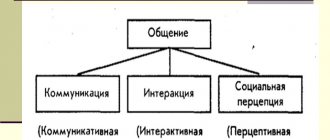Modern society cannot function normally without people interacting with each other. Each personality is individual, but, undoubtedly, it is believed that it must adapt to different situations. This allows a person to find a job, a partner, or go on a trip. A person’s manner of communication and behavior is formed throughout his life. They may change, be supplemented with other techniques, and any one type may be lost. Factors and reasons are very different. There is only one goal: to achieve results. Through communication, a person can achieve a lot; you just need to choose the right style of communication and behavior.
Communication styles
Communication style is characterized by a habitual, stable connection between the methods and methods of communication and the goals it pursues. That is, these are some features of interaction between people. A person is looking for a new job, comes for an interview - here he uses one style of communication, when interacting with colleagues - another, in the family and in communicating with relatives - a third. Different communication styles are chosen for each specific situation. No matter what action is taken, a person's words will always be the basis of communication.
Communication styles from a psychological point of view
Psychology has always dealt with problems of interaction between people. According to psychologists, communication style is determined by a person’s ability to choose certain means of behavior in a certain situation. They divided communication styles into three categories:
- flexible;
- rigid;
- transition.
With a flexible style, a person is well oriented in society, he can adequately assess who is in front of him, quickly understand what is being said, and even guess about the emotional state of the interlocutor. With a rigid style, a person cannot quickly analyze not only his own behavior, but also the behavior of his interlocutor. He has poor self-control and cannot always choose the appropriate way of behavior and communication. With a transitional style, a person has signs from the two above-mentioned styles. He does not fully understand what is happening around him, with whom he communicates and what method of interaction is best to choose.
Signs
What characteristic features correspond to an authoritarian communication style? This:
- All decisions are made by one person, without the ability of other group members to challenge them.
- The opportunity for group members to contribute to the organizational work is minimized or completely absent.
- Suppression of the will and desires of surrounding people, sometimes even contrary to common sense.
- Extremely aggressive behavior in the event of conflict situations.
These signs are characteristic of an authoritarian person, regardless of what group of people he is in, among his family and friends, among his subordinates or his students.
Exploring Communication Styles
When studying communication techniques, you need to know that the style of communication in itself and the style of communication in any situation are different concepts. If you do not take into account the characteristics of a person’s character and the characteristics of the situation in which he finds himself, then the explanation will simply be meaningless. There are a large number of methods for studying communication styles. For example, A.V. Petrovsky created a system of pedagogical interaction consisting of two components. It was called the style of pedagogical communication.
In 1938, attention was paid to communication styles for the first time. German psychologist Kurt Lewin conducted a study and developed a classification of relationships between people who manage and people who are forced to obey. Subsequently, it became generally accepted and is still in effect. His teaching communication styles include:
- authoritarian;
- democratic;
- liberal.
Characteristics of pedagogical communication styles
Pedagogical communication styles were defined as emotional techniques and actions of the teacher in relation to the student. The teacher's behavior is determined by his understanding of the goal that he pursues in teaching the child. Most often, this is nothing more than teaching a child the basics of his subject, transferring skills that the student will need to complete a task, or that will be useful to him in later life. At the same time, the teacher also takes into account the child’s communication styles. Communication with children is completely different from that with adults. The teacher needs a little more time, effort and attention to explain the material to the child. Communication itself occurs through instructions, explanations, questions, comments and even prohibitions.
Types and examples
An authoritarian communication style is often observed in parent-child relationships. At the same time, the parent is not interested in the child’s preferences and hobbies; his vision of the situation is in the foreground.
For example, a father orders a child: “You will play football,” and sends him to a football club, despite the fact that the child is not interested in playing this sport and would prefer to learn to play the piano.
However, the influence of the father remains decisive, who in case of disobedience can punish the child.
Authoritarianism among managers is manifested in the issuance of strict instructions and constant control over their implementation.
The employee is given a clear instruction that he must follow without showing initiative .
For example, a manager orders an employee: “The quarterly report should be on my desk by 2 p.m. today. If you fail to comply, you will lose your monthly bonus.”
The leading incentive with such an order is the deprivation of material benefits to the employee , and the possibility of incentives is not even considered.
The authoritarianism of the teacher when communicating with students can be expressed in a constant focus on the negative assessment of the results of their activities.
For example, a teacher says to an excellent student: “Petrov, you get a 3 on the test, so your quarter grade is reduced to 4,” while the teacher knows very well that the failure of a generally capable student is justified by the fact that he was ill for a long time and missed important thematic lessons.
However, the authoritarianism of the teacher does not allow him to single out the student as an individual, approach him individually and promote extracurricular activities on a missed topic; the teacher is guided by the general principles of assessing the activities of students, without going into specific details.
In married couples, authoritarianism in the communication style of one of the spouses is expressed in the fact that only he makes decisions that generally affect the life of the entire family , without taking into account either the opinions of the rest of its members or the consequences of his own decisions, which may be in some way negative towards other members.
A simple example of this style of communication in a family is when a husband says to his wife: “We are starting to save for a car, so your studies are put off until later.”
This decision sounds like it has already been made and does not tolerate any objections. Moreover, it must be carried out unquestioningly, despite the fact that it may exclude the goals of one of the partners.
Authoritarian communication style
An authoritarian style of communication implies that the teacher reserves the right to resolve issues independently. They can concern relationships between students, activities in the classroom, or concern each student personally. As a rule, such a regime includes both dictatorship and concern for subordinates. With such teachers, students can rarely open up fully and show their capabilities. Initiative can cause conflict between teacher and student. The teacher’s belief that only his thinking is correct and everything else is false does not allow both parties to interact productively. The child's answer cannot be adequately assessed because the teacher simply does not understand the student and is based only on performance indicators. His bad actions always come to the fore in the eyes of the teacher, while the motives for his behavior are not taken into account.
Authoritarianism, concept
Authoritarianism is an inherently political concept, derived from the Latin word “auctoritas” (influence, power), which implies the concentration of power in the state in the hands of one person or a small group of people.
In psychology , authoritarianism is a characteristic of a person who constantly strives to subjugate the people around him as much as possible, influence them, and also achieve certain goals at the expense of others.
The authoritarian style of communication shows itself most clearly in professional, business relationships, as well as in education or training.
However, it can also exist in interpersonal communication , when informal leaders are formed in a group of people, individuals who do not have official leadership rights, but enjoy such strong authority that the rest of the participants in such a social group unquestioningly follow their instructions and demands, and also take them for granted. the comments they make allow them to judge themselves and point out shortcomings.
Democratic style of communication
The democratic style of communication is considered the best, because the teacher strives to help the student, use all his strengths and capabilities, and activate the child’s role in the life of the class. Interaction and collaboration are the main goals of this style. The teacher evaluates, first of all, the good actions of the student, treats him well, understands him and supports him. If the teacher sees that the child does not have time to assimilate information or does not understand something, then he will definitely slow down the pace and explain the material more carefully, putting everything in order. The teacher adequately assesses the student’s capabilities and can predict the direction of his development. He takes into account the interests and wishes of his students. Some methods of teaching and communicating with students of teachers of the democratic style are slightly inferior to the methods of the authoritarian style of their colleagues, but the “climate” in the classroom is still better for the former. Children feel much freer.
Liberal communication style
The teaching styles of a liberal style teacher differ from those included in other teacher communication styles. He strives to reduce all chances of taking any part in the life of the class, and does not want to bear responsibility for the students. The teacher is limited to performing exclusively his pedagogical functions. The teacher's communication styles that he combines in his work lead to poor academic performance. He is somewhat indifferent to the problems of both the school and the children, as a result of which it is very difficult for him to control the students.
Characteristics of business communication styles
Business communication styles imply any actions or methods of communication aimed at achieving any result. In this case, the main task of those participating in the conversation becomes to reinforce the idea of themselves as a member of the team or society as a whole. The participant, as it were, puts on his festive mask and becomes a different person for a while. This peculiar ritual, on the one hand, sometimes seems meaningless and boring, but on the other hand, it is a game, the rules of which a person knows in advance and must follow.
Stereotypes
There is a lot of talk about the authoritarian personality type. Therefore, one should not be surprised at so many speculations about her. The main one says that people prone to authoritarianism are always narrow-minded, lack moral values, show violence, and manipulate others. For many, they are despots and even fascists. This view was adhered to and promoted by E. Fromm and K. Levin.
How are things really going? An authoritarian personality really strives for power, often showing despotism. But she can do this in other ways. One of them is to create a respectful atmosphere around himself, which will help him build authority.
It is difficult to say unequivocally whether it is good or bad to be an authoritarian person. But it is worth noting that many managers of large companies and enterprises are like this. And this can be considered a reason for pride, since this quality helps them work more efficiently than others.
People who tend to be authoritarian often place high demands on themselves and others. This is another plus. They not only exercise discipline themselves, but also teach it to their subordinates. The exception is when an authoritarian person demands a lot from others, but at the same time remains disorganized.
Ritual style of communication
Business communication styles like ritual are often used in companies whose members have known each other for a long time. And so they meet, spend some time together, and it seems that after these years the topics discussed in these companies do not change at all. Sometimes you can even predict what one or another participant in the conversation will say, but, nevertheless, everyone is happy with everything and after the day, some even feel satisfied with the time spent. This style of communication is considered a typical case of a ritual style, where the quality of communication comes to the fore, and not its content. Thus, the same reinforcement of the idea of oneself as a member of a team occurs, where everyone occupies some place, everyone is important. His opinions, values, and worldview are important.
Cases when a person who, when asked: “How are you?” always answers unequivocally: “Fine,” and now suddenly begins to tell a detailed story about his life, family, children and work, which is called going beyond the ritual. Such atypical behavior of a person, whose reaction could always be guessed, violates the idea of ritual, because the main thing is to wear a mask, be it in social relationships or interpersonal ones.
Manipulative communication style
With this style of communication, a person is perceived by others as a means to an end. As a rule, the interlocutor tries to show the best aspects of his goal so that he can help him achieve it. Despite the fact that both participants in the conversation have different ideas about the component of this goal, the one who is more skillful in the methods of manipulation will win. In such cases, the interlocutor knows about the reasons for the partner’s behavior, about his aspirations, desires, and can turn the development of events in the direction he needs. Manipulation is not necessarily a bad method. Many goals are achieved this way. Sometimes, in order to convince a person to do something, to force him to act, it is necessary to resort to a manipulative communication style.
This can be compared to the communication method of a middle manager. He speaks in one tone with his superiors, but with his subordinates in a completely different tone. Sometimes it is unpleasant, but there is no other way.
There are cases when a person’s entire communication style comes down to manipulation. Due to the too frequent use of this method on a person, his constant persuasion and pushing, the latter may consider manipulation the only correct way out of the situation.
Personality-oriented style, or “Don’t be afraid, I’m with you”
Olga B. worked with both Gennady Pavlovich and Alexey. The woman realized that both authoritarian and democratic styles have their pros and cons, and decided to act differently. Actually, she didn’t come up with anything new - she used a completely individual approach. Olga realized that you need to work with each employee in your own way, and what is suitable for one is categorically unacceptable for another. For example, a quiet person may be shy at general planning meetings and brainstorming sessions, but during a personal conversation he will begin to burst out with creative ideas. It is difficult for an owl man to arrive at the office at 9 am - his head is not clear, things are not getting done, but in the evening the most fruitful time comes. Olga organized a free schedule for several of her comrades and allowed introverts not to speak at the planning meeting in front of everyone. The employees appreciated the good attitude and began calling the boss “our mommy.” But there’s nowhere without a fly in the ointment: a group of people quickly emerged who considered a good attitude a weakness and began to openly neglect work. Olga was worried, had soul-saving conversations, and only when the team submitted a collective request for the dismissal of those at fault, she decided to take a bold step.
Practicing an individual approach is the right thing to do. Typically, bosses of this type (usually women) like to conduct psychological testing, organize corporate parties and get-togethers in order to get to know their employees better. However, you shouldn’t overprotect your employees: you are not a mother hen, and they are not helpless chickens. Trust, but verify, be not a mommy, but a boss - this is the moral of this fable.
Disadvantages of a person-centered approach
- As a rule, bosses of this type are soft, sensitive people. Good relationships are more important to them than the company’s profit and its development. Therefore, sad as it may be, a soft-spoken boss can quickly be “eaten up” by his more resourceful colleagues or one of his subordinates.
- No delegation of authority. Instead of clearly issuing instructions and monitoring the process of completing tasks, such managers either do everything themselves or forgive endless delays. Wake up guys, this is a business! Here you need to make tough decisions and take big risks, otherwise you risk going broke and going bankrupt.
Advantages of an individual approach
- Good relationships in the team. Human relations are perhaps the most important thing for half of the employees. If you are lucky enough to find an understanding boss, many will hold on to this position with their hands and teeth, even despite the low salary and small career prospects.
- In a crisis situation, employees will stand behind the boss and will not allow the company to collapse . “One for all, and all for one” - this slogan still works.
Humanistic style of communication
With the humanistic style of communication, we are talking about interpersonal relationships in which a person wants to be understood, supported, given advice, to be empathized with. Initially, this type of communication does not imply any goal; the situation consists of ongoing events. This style of communication can be called the most sincere of all existing ones, where those very events are intimate, confessional in nature. The main method that works here is suggestion, and mutual. Each partner inspires the other that he is worthy of trust, that one is ready to listen, and the other is ready to tell what worries him.
Such communication can occur not only between loved ones and relatives. For example, in a few tens of minutes a person can recognize the interlocutor who is traveling with him on the bus in the next seat or tell him a lot about himself, but he does not know the person with whom he has been working for several years. A conversation with a fellow traveler leads to some revelations about oneself, makes people feel each other, and empathize. But a conversation with a colleague has completely different goals.
Models of organizational behavior
The differences in the results of organizational systems are largely caused by the models of organizational behavior used, that is, the dominant belief systems in management thinking that determine the actions of the management of each company. Understanding by organizational managers of the nature, meaning and effectiveness of the organizational behavior patterns that guide them and the prevailing patterns of their employees is extremely important.
Enormous credit for attracting attention and developing the theory of management models belongs to Douglas McGregor. Taking into account the different attitudes of people towards work, he identified two theories: “X” and “Y”.
Theory X is a traditional set of assumptions about human nature, and in particular that most individuals have a negative attitude towards work and try their best to “get out” of having to work. Proponents of Theory X argue that workers tend to limit their work efforts, are unambitious, and tend to avoid responsibility when possible. They are perceived to be relatively self-centered, indifferent to organizational needs, and resistant to change, with conventional rewards failing to overcome their natural aversion to work. Therefore, in order to achieve satisfactory performance, such employees (in accordance with the basic tenets of Theory X and its logic) must be subject to coercion and an expanded sphere of control. Theory X reflects a very common view among managers about employee behavior.
Theory Y takes a more humanistic and supportive approach to managing people's work lives. It assumes that a person is by no means a born lazy person; work for him can be a source of inspiration or punishment, and will turn into as natural a need as entertainment, rest or relaxation. In accordance with Theory Y, the potential of the average person is not used to its full extent; he strives for responsibility and creative problem solving (Table 1).
Table 1 . The main provisions of Theory X and Theory Y by D. McGregor
| Theory X | Theory Y |
| — The typical individual has a negative attitude towards work and, as far as possible, will try to avoid participation in work — The typical individual is not inclined to take responsibility, is unambitious and, above all, needs security — People’s participation in the work process is carried out only under coercion, under the control of management B According to the logic of the model, the main role of management is to force labor and control the actions of workers | - Work is as natural for a person as play or rest - A person is by no means a born lazy person. His negative attitude towards work is the result of acquired experience - When solving assigned tasks, employees will independently regulate their activities and control the work process - The potential inherent in a person allows employees, in the right conditions, not only to take on themselves, but also to seek additional responsibility. They have imagination, ingenuity and creativity, which can be used in the work process. According to the logic of the model, the main role of management is to develop the potential needs of workers and to assist them in applying them to solve common problems. |
Based on the above theoretical constructs, D. McGregor came to the conclusion that the top management of many organizations was guided by an outdated set of assumptions about human nature (Theory X). From a scientist's point of view, Theory Y is more realistic. Representatives of the human race differ significantly from each other, but the characteristics of only a few of us fully correspond to the assumptions of Theory X. And at the same time, almost all employees have some potential for developing their capabilities and improving achieved performance indicators of work assignments. Thus, management needs to replace the entire set of assumptions about human nature with modern ones based on the latest research from the behavioral sciences.
Any management model is based on certain assumptions about human nature, which determine the nature of the interpretation of events and contexts that allow us to predict the development of the situation. Basic, consciously or unconsciously developed paradigms become powerful guides of managerial behavior.
Currently, researchers identify four models (paradigms) of organizational behavior: authoritarian, guardianship, supportive and collegial (Table 2).
Table 2 . Models of organizational behavior
| Authoritarian | Guardianship | Supportive | Collegiate | |
| Model basis | Power | Economic resources | Management | Partnership |
| Management orientation | Authority | Money | Support | Teamwork |
| Worker orientation | Subordination | Safety and benefits | Completing work assignments | Responsible Behavior |
| Psychological outcome for the employee | Dependence on immediate superior | Organization Dependency | Participation in management | Self-discipline |
| Satisfying employee needs | In existence | In safety | In status and recognition | In self-realization |
| Participation of workers in the labor process | Minimum | Passive cooperation | Awakened Stimuli | Moderate Enthusiasm |
Because each organization is unique, organizational behavior practices may vary across departments and subsidiaries. For example, the production department of a company follows a custodial model, while the research department follows a supportive model. And, of course, often, due to differences in the priorities of subordinates and the conditions of departments or divisions, the practical methods of each of the managers of the organization are very different. Thus, one model is not enough to describe the practice of organizational behavior, but identifying the dominant one allows us to understand how the life of one company differs from the life of another.
The choice of organizational behavior model is determined by many factors. The prevailing philosophy, vision, mission and goals of the organization and its managers influence (and are in turn influenced by) patterns of organizational behavior. In addition, we should not forget about the environmental conditions to which one of the models is adequate. For example, the volatility of markets (which places high demands on flexibility and speed of decision-making) is forcing organizations to move to collegial models. Therefore, the model of organizational behavior cannot be static, but must change in accordance with the needs of the time.
AUTHORITARIAN MODEL
The authoritarian, power-based model of organizational behavior dominated the Industrial Revolution. In order to demand from a subordinate “you must do this - or.”, the manager must have the appropriate authority to impose penalties on an employee who does not obey orders.
Thus, in an autocracy, managers are focused on formal, official powers delegated through the right to give orders to subordinates. Management is confident that its knowledge is “absolute”, and the duty of employees is to unquestioningly carry out orders. It is assumed that workers must be directed and forced to work, which is the main task of management. This approach provides for strict management control over the labor process. It is obvious that heavy, exhausting physical labor, unbearable production conditions, illness, foul language, threats and lack of resources (inevitable companions of the authoritarian model) caused an extremely negative attitude of workers towards management.
In conditions of autocracy, employees are focused on subordination to the leader, due to which there is a psychological dependence on the boss, whose power to hire, fire and “work to the bone” of a subordinate is almost absolute. The salary level in the organization is low due to the fact that the results of workers’ labor are minimal. This circumstance is due to the fact that employees strive to satisfy, first of all, their basic needs and the basic needs of their families. Some of them demonstrate higher performance due to some internal incentives (they feel sympathy for the leader, the boss is a “natural leader”); however, the majority of workers show low production rates.
Under certain conditions, the authoritarian model demonstrates high efficiency; especially when it is necessary to strengthen labor discipline, when it is necessary to bring the enterprise out of a crisis. However, its fundamental weakness is its high human costs.
GUARDIAN MODEL
Labor relations research has shown that although authoritarian leadership does not involve verbal feedback from subordinates to superiors, “mental feedback” certainly exists. The worker could and would like to speak out, and sometimes, when he lost his temper or lost patience, he “threw out” his thoughts and feelings. Since workers had no outlet for their emotions, they often took it out on their families and neighbors; thus, the lack of “publicity” had a negative impact on the entire community.
It would seem obvious that there must be some method to help employees develop a sense of job satisfaction and a sense of security, which would reduce the level of frustration and aggression and increase the sense of work life. The search for such methods led to the fact that at the end of the 19th - beginning of the 20th centuries. Some companies began implementing welfare programs, a practice that later became known as paternalism.
In the 1930s The joint efforts of employers, trade unions and governments have improved worker protection. was born . Firms have developed unique methods to stabilize the workforce and preserve jobs. To avoid suspension of production, they constantly retrain workers, strive to reduce the need for overtime work, suspend hiring, and encourage both changing professions and changing places of residence, and early retirement.
The success of the guardianship model depends on economic resources. The efforts of the organization's management are aimed at providing the funds necessary to pay salaries and provide benefits. Since the physical needs of employees are adequately met, the employer considers the employees' need for safety as a primary motivating factor.
Guardianship leads to increased dependence of the employee on the organization. The employee feels that his weekly earnings depend on his immediate superior, understanding that his safety and well-being largely depend on the organization. Or, to be more precise, as personal dependence on the leader decreases, subordination to the organization increases. An employee who has worked for a company for ten years and earned himself a decent additional pension cannot afford to leave it, even if “the grass seems greener” somewhere else.
Within the framework of the guardianship model, a wide variety of programs are implemented. Thus, the American mutual fund Calvert Group provides its employees with the opportunity to engage in physical exercise for free, provides therapeutic massage services, conducts psychological seminars, provides leave for parents, and allocates time to care for dependents and children. As a result, Calvert's employee turnover rate decreased by 30%, the amount of funds allocated to pay for sick leave decreased, and the costs of recruiting and training decreased. It is obvious that the fund’s employees are unlikely to be eager to change their “guardian” employers.
The guardianship model assumes that company employees are constantly indoctrinated with ideas about economic incentives and benefits. As a result of this kind of psychological treatment, they feel quite satisfied with life. However, the feeling of satisfaction is by no means a strong incentive; it causes passive cooperation. This is why the effectiveness of the guardianship model is only slightly superior to the performance achieved under the authoritarian approach.
Its main advantage is that the model gives workers a sense of security and satisfaction, and it does not have any significant weaknesses. The most obvious shortcoming of the model is that the level of labor effort of most workers is somewhere on the edge of their potential capabilities, because they lack the motivation to develop abilities to a higher level.
SUPPORTIVE MODE
The supportive model does not rely on money or power, but on leadership, or leadership, where managers create a climate that helps employees grow individually and use their abilities to benefit the organization. A true leader believes that employees are active by nature and strive to meet the needs of the organization, and passivity and indifference are the product of an inadequate work environment. If management gives them the opportunity, employees are willing to accept responsibility, contribute to work assignments, and chew on new knowledge.
Thus, the task of management is to support the efforts of workers to complete work tasks, and not simply to provide benefits and pay bonuses, as in the guardianship model. In cases where a leader supports the efforts of employees, employees develop a sense of complicity and involvement in solving the organization's problems, and they have a reason to talk about, rather than “they.” Employees' motivation to work increases, since their needs for status and recognition are satisfied at a higher level; Thus, their internal impulses to work are awakened.
Supportive behavior does not require significant monetary resources. We are talking, rather, about the style of behavior of the organization's management, which is manifested in the way managers treat people. The role of a manager is to help employees solve problems and complete work assignments.
The supportive model is effective for both workers and managers and is widely accepted (at least as a philosophy) in the United States. Of course, the fact that a manager shares the basic ideas of the supportive approach does not mean that he regularly and effectively uses them in practice. Moving from theory to practice is a very difficult step, but a growing number of companies are reporting the benefits of supported walking.
In response to declining computer sales at Hewlett-Packard, Hewlett-Packard's chief executive, John Young, ordered workers in certain divisions to take two days of unpaid vacation per month (to avoid a production shutdown). But many employees came to work on days for which they were not paid. Moreover, managers of the divisions that remained profitable, as a sign of solidarity with the company's employees, took the initiative to reduce their salaries by 10%.
Perhaps the use of a supporting approach during a prosperous period is a form of investment whose dividends are “paid” during difficult times for the company. The supportive OP model is particularly effective in countries with high levels of prosperity because it meets the desire of workers to satisfy a wide range of needs. Its use in developing countries is hardly advisable, since even the material needs of workers are not always satisfied in them. However, as they become saturated and become familiar with the practice of foreign management, conditions are created for the transition to a supporting model. Thus, in underdeveloped countries, an accelerated transition along the “rungs” of the ladder of OP models is possible.
COLLEGIUM MODEL
The collegial model is a further development of the supportive OP model. The term collegial refers to a group of people striving to achieve a common goal. Initially, the collegial model, which includes the concept of a team, became widespread in research laboratories and organizations whose activities were determined by the creative attitude of employees to work responsibilities, since it is most adequate to the conditions of intellectual work and significant freedom of action of employees. The possibilities of its use in traditional (conveyor) production are limited by strict labor organization conditions.
The success of the collegial model is determined by the possibility of forming (under the guidance of management) among employees a sense of partnership, a sense of their necessity and usefulness. When employees see that managers are contributing to achieving a common goal, they seem to “accept” managers into their circle and respect the roles they perform.
The management of such an organization is focused on teamwork, when the leader is treated as a coach who creates a winning team.
The psychological result of using a collegial approach for an employee is the formation of self-discipline, when employees who feel a sense of responsibility independently set certain boundaries for their behavior in the team, just as members of a football team must adhere to certain rules of the game. In this type of environment, employees typically experience feelings of accomplishment, contribution, and self-fulfillment, which in turn translate into moderate enthusiasm for completing work tasks.
Analysis of models of organizational behavior shows that the development and change of models are evolutionary in nature; they are largely determined by the prevailing needs of workers; There is currently a trend towards the use of new models; The effectiveness of the model largely depends on the specific situation. In addition, models can be modified and developed in various directions.
As our individual or collective understanding of patterns of human behavior deepens, or as new social conditions emerge, business and society move toward more advanced models.









